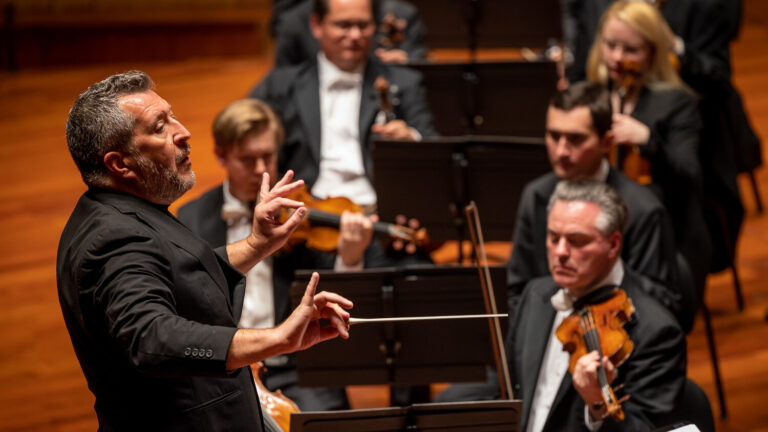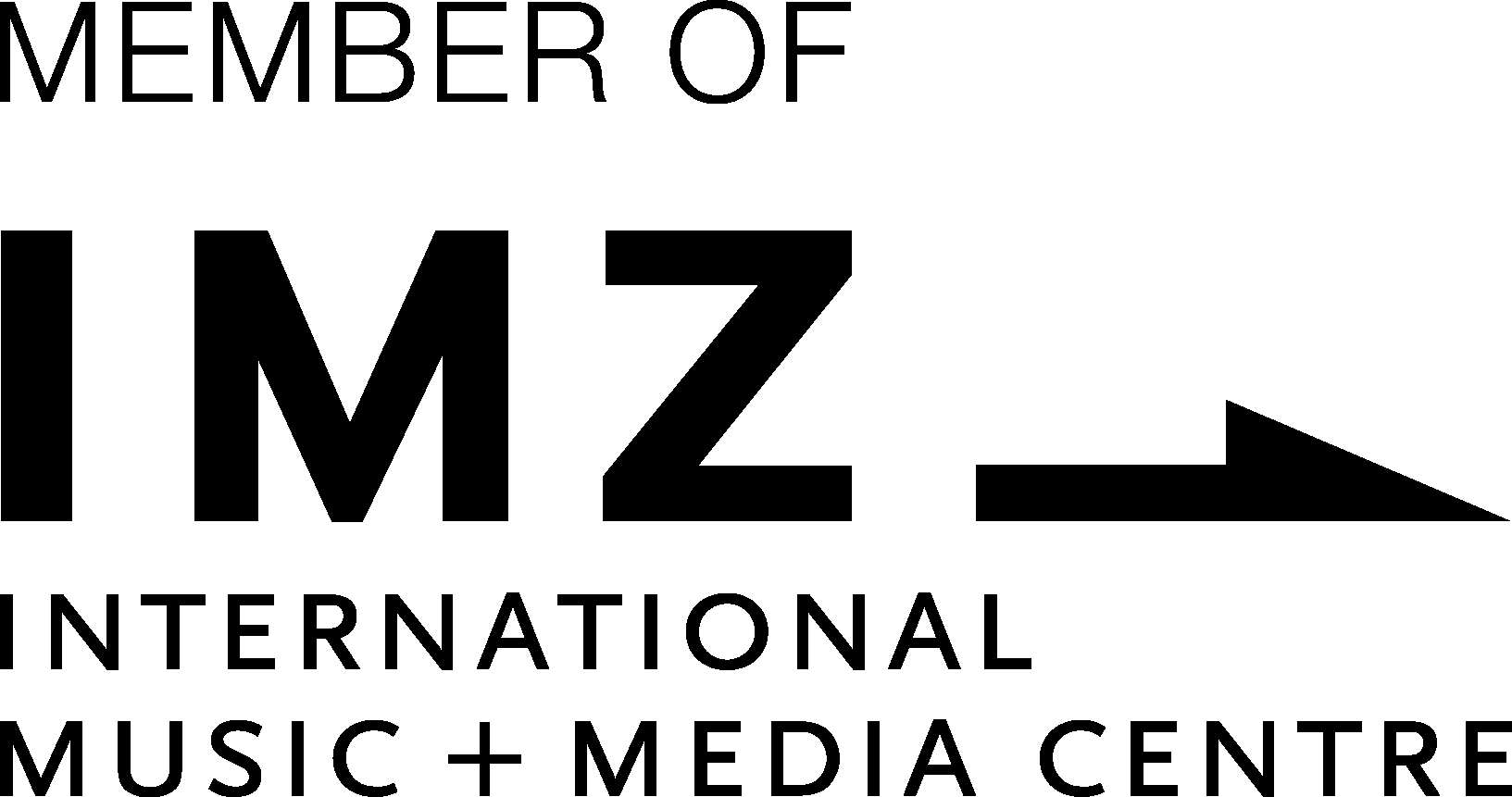When Thomas Adès composed his “Totentanz” in 2013, I’m sure he had no idea that it could predict the future. When Alban Berg wrote his “Three Pieces for Orchestra” Op. 6 in 1914, I’m guessing he knew it could be predictive, since Europe was on the cusp of WWI. Although Maurice Ravel flatly denied his 1920 “La Valse” had any connection to the post-WWI Trianon tragedy, this orchestral bombshell paints a turbulent portrait that easily fuses the zeitgeist of war’s collateral damage with an unearthly waltz of terror.
At Müpa Budapest on 29 March, these three works were performed by the Vienna Philharmonic, directed by Thomas Adès, in his Hungarian début. The experience left me reeling with shock at how these pieces intersected with each other in such ironic, historical, and almost psychic ways. It gave me the same feeling I get when I watch a futuristic sci-fi film, and years later we all witness later how it all came true. But beyond that, this program at Müpa was one of the highlights of the season in terms of witnessing these great artists and their artistry, as well as their stunning programmatic brilliance which bound them together in a thematic wizardry that, by sheer timing, included the spooky, nervous potential of nuclear war just across Hungary’s eastern border.
Berg’s “Three Pieces” could be a soundtrack for a horror film – not that it freaks us out in cinematic terms, it’s only so evocative by using many sound textures that allude to evil and the machinations of evil-doers. The three movements begin with a ghoulish “Praeludium” that is as foreboding as any other gloomy music ever written. The “Reigen” (Round Dance) is a furious chaos portrayed by fiendishly difficult string acrobatics, and the final “Marsch” delivered — after a regiment of bubbling bassoons bleeding in lockstep — the final Mahlerian blow: the hammer of death as the last word. “To the guillotine!” it seemed to scream. Now Berg’s music, generally speaking, is not as fierce as this, but I’m willing to assume that the spectre of what Europe was about to experience was on his mind in this piece as much as it was in Benjamin Britten’s mind when he wrote his “War Requiem.”
“La Valse” is like a Viennese waltz on LSD. Watching Adès conduct this psychedelic music was part of the magic, as he balletically torques and twists his body throughout, mimicking sounds through hand signals to the players. In one particularly scintillating phrase, his hand went up in the air as if to throw out some fairy dust as the flutes and piccolos spun out a circular flurry of high notes. Ravel’s orchestrational magic, so perfectly executed by the well-oiled engine that is the Vienna Philharmonic, used every instrument to its Nth degree in creating this demon-dance that destines every imagined dancer to a death spiral.
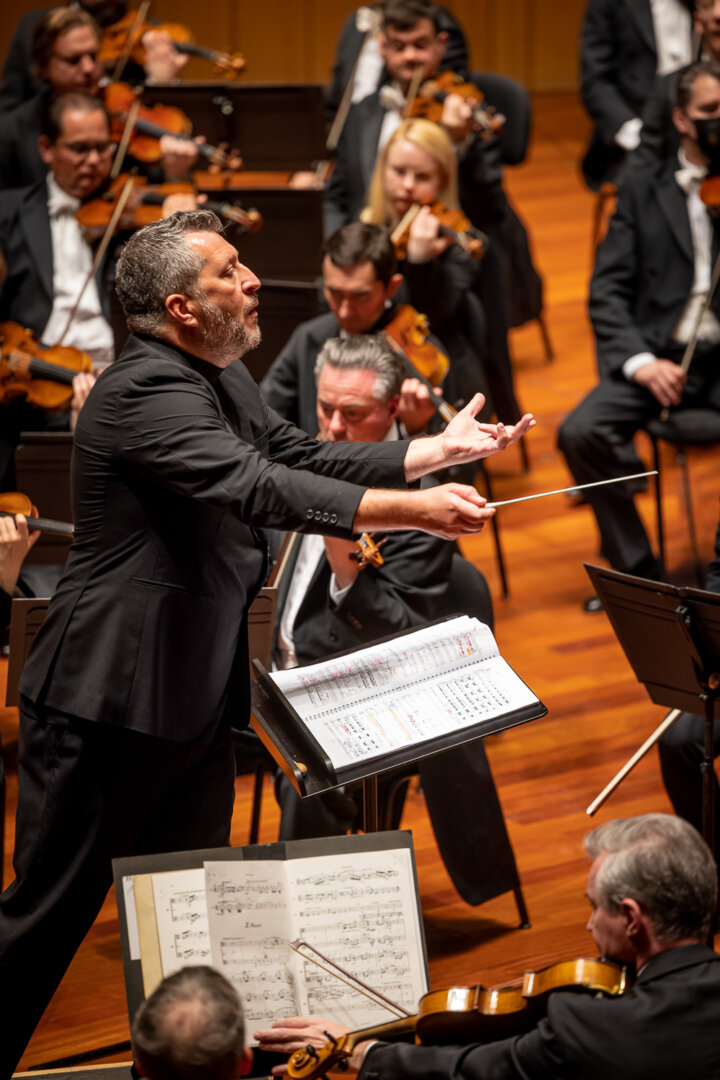
The score of “Totentanz” includes seven percussionists. This is a good sign that we’re in for a great ride. Adès drew his inspiration from 15th century texts and images carved on a church in Lübeck. Two main characters: Death (as demon and truth-teller) and Maiden (as vox populi), shepherd the viewer/listener through a pictorial dance journey wherein the Pope, the King, the Mayor, a doctor, a judge, a merchant, a banker, and a child are asked pointed questions about the nature and veracity of their existence. Death’s voice of damnation was intoned by bass-baritone Mark Stone, and the Maiden’s fervent pleadings by mezzo-soprano Christianne Stotijn – both of whom have performed and recorded this work.
Because it’s so text-driven, it’s necessary to read the words in order to link the soundscape to the emotions of each statement. “Though you think you might, no one can live forever. Wake up, Emperor!” was the first vocal salvo, followed by the Devil bidding everyone to join in the dance: “Pope, come crawl out of the Vatican and enter this coffin!” while mocking various Lords and Kings for their indiscretions. This colorful clamor of comical cataclysm conjured up the perfect soundtrack to a Hieronymous Bosch* painting.
Adès’ scoring behind the singers was thankfully adept at giving the soloists the acoustical spotlight, never making them try to scream above the orchestral din. Confessing her sin of acquisition (i. e., compulsive shopping) the Maiden admits her slothful ambitions, to which Death says: “You repeatedly concoct a lie?” What a startling conjunction to the present mass-media miasma! A particularly vivid observance from Mr. Death: “Doctor, examine yourself – not the sick man’s glass!” pulled me directly into the last two years of the dysfunctional medical machinations that kept everyone shaking in fear.
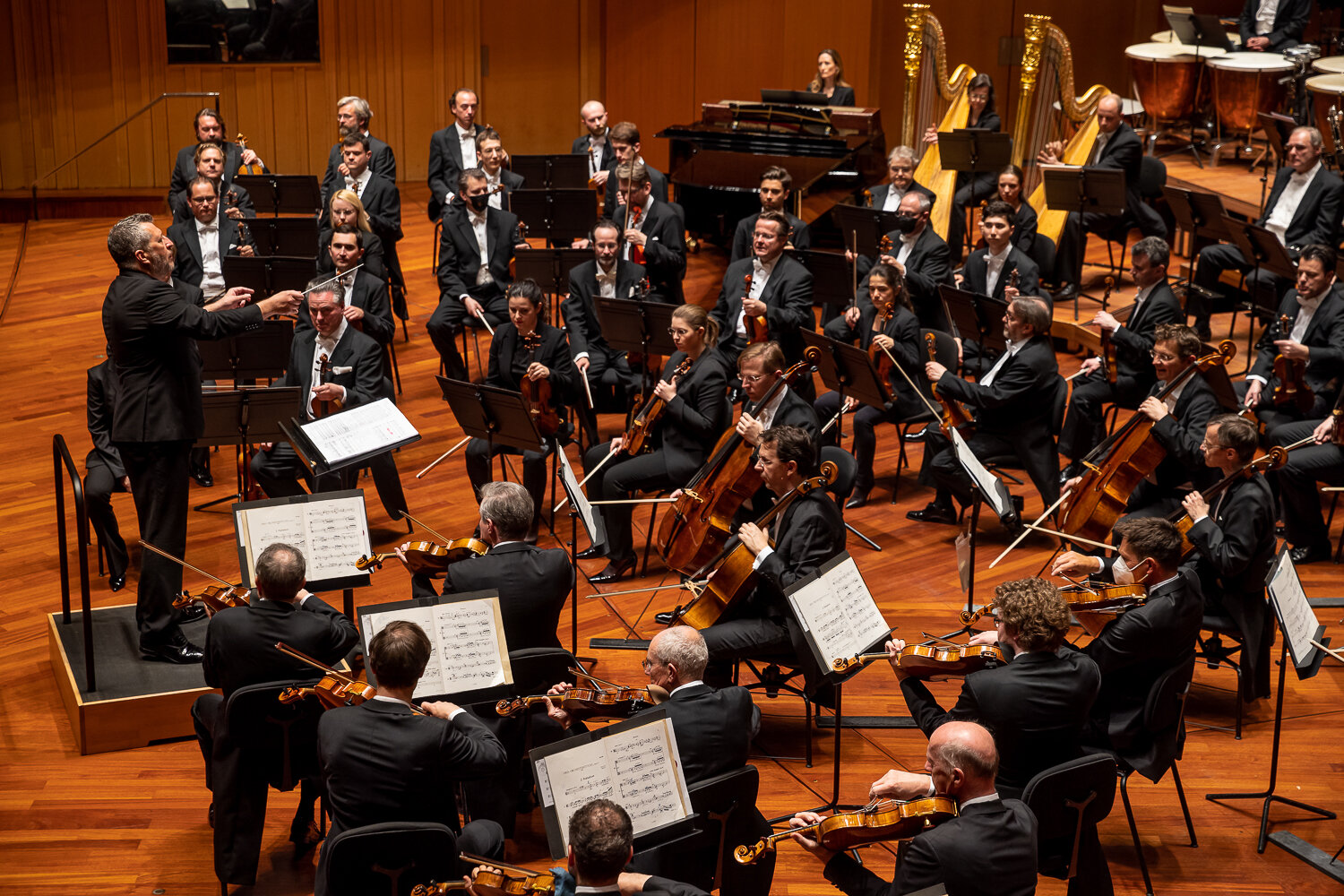
“Totentanz”’s kaleidoscope of orchestral richness tied to the text is so dense that it takes repeated hearings to catch most of it. It doesn’t wait for you to catch up with its tossing up found objects from the underworld to your ears. It’s possible he’s paced it so that you cannot grasp all of it in one sitting: the content is controversial and likely to start fires. The one moment of absolution is a three-minute Mahlerian moment where the sweet key of E-flat major is announced by the French horns to accompany “You tender babe, under the untimely blow of the scythe…” before the complete disintegration of the divided society, dramatically presaged and outlined by the eight double basses scrubbing and grumbling, slowly, slowly, fading into the breathless ether—as if the plug had been pulled from the last victim’s ventilator.
The wonderful thing about music like Adès’ is that no two people will have the same opinion of it. It’s so intense, so passionately descriptive of the inner psyche’s dreams and nightmares, as much as adhering to rich textual sources like Shakespeare’s plays, poets, and inscriptions on ancient walls. On this March evening, his programmatic choices eloquently and artistically expressed my personal rage: rage at the machine, at the forces we cannot control, the forces that attempt to control us, and the rage at potential loss of one’s inborn sovereignty in the looming new world order. It’s as if Adès took the cue from Shostakovich and exercised his last-minute right to self-expression by employing an artillery of seven percussionists (and two prominent contrabassoons droning in the inky depths) to do the battle for him. And the Vienna Philharmonic, in all its magnificence, was the perfect vehicle to send the message.
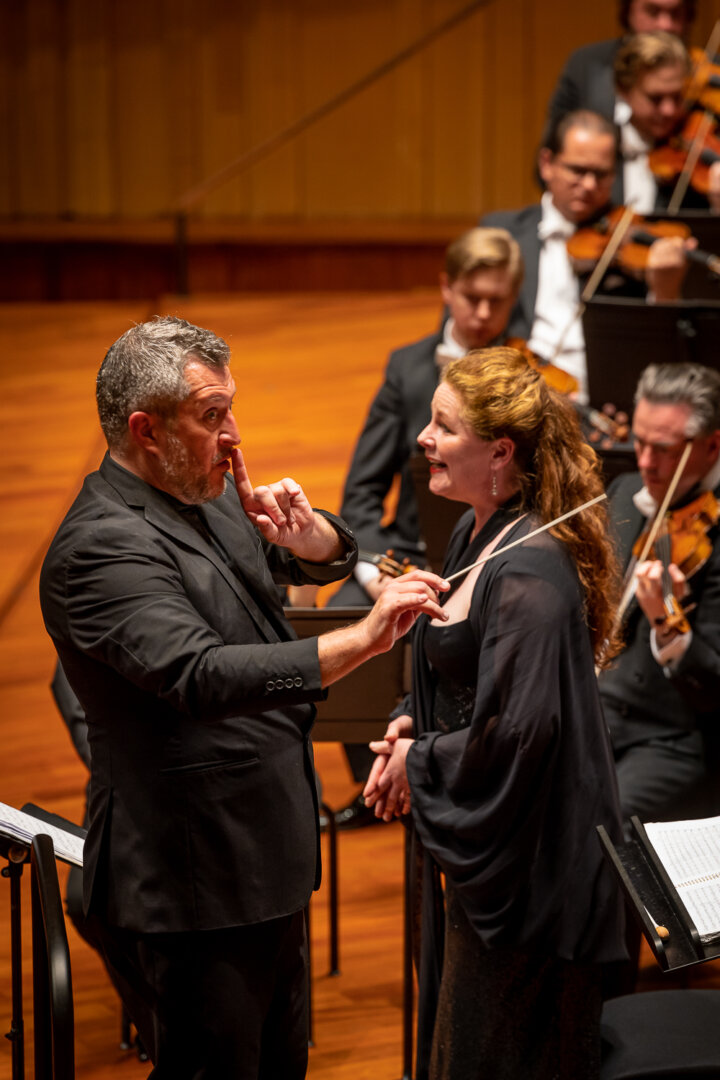
Adès is one of the world’s most heralded living composers. Honored by his native Britain and lauded by numerous critics and international audiences, Adès’ bio is a litany of triumphant premieres, honoraria, and recognition throughout the global art music spectrum. His opera “The Tempest” was performed by the Hungarian State Opera in 2016, to great applause. That was my first exposure to his music and I wrote a glowing review. After hearing “Totentanz” conducted by this composer, I cannot wait to hear what Adès cooks up next.
One thing is certain: if this same program had been presented in New York City, it would have been a sold-out ‘cause celebre’ where VIPs and the glitterati gathered, and tickets would have been sold at scalper’s prices. The fact that this spectacular event happened here in Budapest, in Müpa’s Béla Bartók Hall’s superb acoustics, and for reasonable ticket prices, is a precious cultural reality that should be consistently appreciated by Hungarians.
[Opinions expressed here are those of the writer and not of Papageno.]
* An exhibit, entitled “Between Heaven and Hell: The Enigmatic World of Hieronymous Bosch” opens 9 April at the Budapest Museum of Fine Arts

